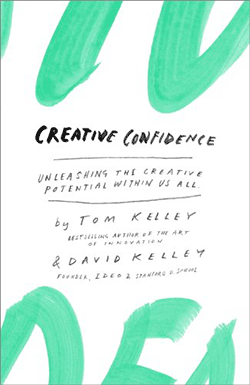In truth, everyone has the capacity for creativity, but things happen along the way to adulthood and in our pursuit of a profession. Some come to believe that everything is a competition and judge each other’s skills and execution in drawing, painting, and other creative endeavors. Again, they focus on the work product rather than the process. Many assume that those who are particularly successful in creative endeavors are somehow special. In the words of David Kelley, people opt out of creativity.
Now, we arrive at the topic of design and design thinking, which people often lump together with creative activities. I think it is one of the unfortunate accidents of our language that design is both a verb and noun. More often than not, design is used as a noun with a descriptor—interior design, fashion design, graphic design, cake design, and so on. Such uses of the word impact its perception and, ultimately, reduce its significance and power. People do not perceive design as an activity, but simply an attribute—and often confuse design with the visual aspects of a product. They might say, “I like the design of the new iPhone.”
Creative Confidence may at first come across as an idealistic discussion of creative processes and their applicability in our world. In reality, Tom and Dave’s attitude toward creativity is more of a can-do approach to solving problems. Growing up in Barberton, Ohio, the Kelley boys didn’t have the luxury of buying a new washing machine when their old one broke. They had to figure out how to fix it. Sometimes they had to improvise solutions when they couldn’t procure the right replacement part. They had understanding parents, so by taking things apart and trying to put them together again, the Kelleys developed the confidence to try new things. Ultimately, they developed the optimistic attitude that trial and error are ways to learn, not a repetition of failure.
In Creative Confidence, the Kelley brothers present a series of anecdotes that illustrate the phenomenal successes that people and organizations can realize when they unlock their creative capacity. One story Tom and Dave share in the book is that of Doug Dietz, an MRI engineer who embraced creativity and design thinking to improve patient outcomes. (I won’t go into the details here. You’ll have to read the book or find David’s TED talk.)
Creativity has tangible value, and the design thinking methodology is an effective means of realizing that potential. The popular news aggregator Pulse was conceived in a Stanford d.School workshop. The duo who designed the app—employing a fast-paced, experimental approach to designing an experience—ultimately sold the app for $90 million, less than three years after its initial launch.
 Tom Kelley and David Kelley, coauthors of Creative Confidence: Unleashing the Creative Potential Within Us All, are men on a mission. Tom Kelley is general manager of IDEO, a design consultancy specializing in product development and innovation. David Kelley is a founder of IDEO and has been a leader in establishing the concept of design thinking. After experiencing decades of success working with—and designing for—many of the biggest companies in the world, then surviving cancer, David Kelley has committed his life to helping others to realize their creative potential. After seeing his interviews and a TED talk, running into him at the airport, and reading Creative Confidence, I believe that his message is not just inspiring, but actionable.
Tom Kelley and David Kelley, coauthors of Creative Confidence: Unleashing the Creative Potential Within Us All, are men on a mission. Tom Kelley is general manager of IDEO, a design consultancy specializing in product development and innovation. David Kelley is a founder of IDEO and has been a leader in establishing the concept of design thinking. After experiencing decades of success working with—and designing for—many of the biggest companies in the world, then surviving cancer, David Kelley has committed his life to helping others to realize their creative potential. After seeing his interviews and a TED talk, running into him at the airport, and reading Creative Confidence, I believe that his message is not just inspiring, but actionable.